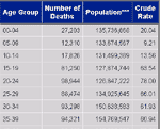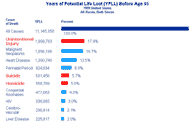|
 |
WISQARSTM
Fatal
Help Menu
|
|
Choose
a help topic. |
1.0
Tutorial:
A step-by-step introduction to using WISQARS Fatal
2.0
About Mortality (Fatal Injury) Reports:
An overview of mortality reports and the
options offered
3.0
About Leading Causes of Death Reports:
An overview of leading causes of death reports and the options offered
4.0
About Years of Potential Life Lost Reports (YPLL):
An
overview of years of potential life lost reports and the
options offered
5.0
Definitions of Report Data Elements:
Thorough definitions of the data elements mentioned in
the report request options and in the reports themselves
6.0
Data Sources:
Further explanation of the purpose of and data sources for WISQARS
Fatal and the process of compiling the data
7.0
Frequently Asked Questions
Answers to common questions about WISQARS
Fatal.
8.0
References:
References used within this help file.
|
|
2.0 Mortality
(Fatal Injury) Reports - Overview
|
 WISQARS Fatal's mortality reports provide tables of
the total numbers of injury-related deaths and death rates per
100,000 population, using the
annual mortality data compiled by the National Center for
Health Statistics (NCHS), CDC. For more information, see Data
Sources. WISQARS Fatal's mortality reports provide tables of
the total numbers of injury-related deaths and death rates per
100,000 population, using the
annual mortality data compiled by the National Center for
Health Statistics (NCHS), CDC. For more information, see Data
Sources.
You can request a report to list deaths by
- Cause (mechanism) and
intent (manner) of injury
- Census region / state of
residence
- Race
- Hispanic origin
- Sex
- Age
- Year(s) of report.
In addition, the reports offer advanced options of
- Output groups
- Age
adjusting
- Age selection.
Back
to Help Menu
|
|
3.0 Leading
Causes of Death Reports - Overview
|
|
 Leading causes of death reports use the
annual mortality data compiled by the National Center for
Health Statistics (NCHS), Centers for Disease Control and
Prevention, to compute the leading causes of death in the
United States. These tables help show the impact of a
particular cause of death and highlight the role that
injuries play in U.S. mortality. Leading causes of
death reports display the major causes of death from
greatest to least. The reports show which causes
result in the most deaths. The colored boxes in the
leading causes of death report highlight
injury deaths, and show the number
of injury deaths by underlying-cause-of-death International
Classification of Diseases (ICD) codes. Simply click on a
colored box to view Injury deaths by individual ICD
codes; then follow the instructions below the table title.
For more information, see Data
Sources. Leading causes of death reports use the
annual mortality data compiled by the National Center for
Health Statistics (NCHS), Centers for Disease Control and
Prevention, to compute the leading causes of death in the
United States. These tables help show the impact of a
particular cause of death and highlight the role that
injuries play in U.S. mortality. Leading causes of
death reports display the major causes of death from
greatest to least. The reports show which causes
result in the most deaths. The colored boxes in the
leading causes of death report highlight
injury deaths, and show the number
of injury deaths by underlying-cause-of-death International
Classification of Diseases (ICD) codes. Simply click on a
colored box to view Injury deaths by individual ICD
codes; then follow the instructions below the table title.
For more information, see Data
Sources.
You can request a leading cause of death
report by
- Census region / state
of residence,
- Race,
- Hispanic origin,
- Sex,
- Year(s) of report,
or
- Number of causes.
In addition, the advanced options allow you to
- Format
the report by age group;
- Request statistics for
- leading causes of
death (and ICD code
detail),
-
leading causes of injury death
- unintentional causes
of injury death
- violence-related
causes of injury death
- Choose the number of causes reported for each age
group;
-
Download data from a chart or graph into a spreadsheet;
-
Capture and transfer a chart or graph into Power Point
or other software.
Back
to Help Menu
|
|
4.0 Years of Potential Life
Lost (YPLL) Reports - Overview
|
 Years of potential life lost (YPLL) is a measure of premature
mortality (early death). YPLL provides insight into the
impact of injury-related death on society compared to other
leading causes of death. This measure is important for injury
prevention because injury is the leading cause of death for
persons aged 1 through 34 years. In 1999, unintentional injury
was the 5th leading cause of death in the United
States, accounting for 97,860 deaths. Also,
unintentional injury was the leading cause of years lost
before age 65 (YPLL-65) with 1,999,783 years lost. For more information, see Data
Sources.
Years of potential life lost (YPLL) is a measure of premature
mortality (early death). YPLL provides insight into the
impact of injury-related death on society compared to other
leading causes of death. This measure is important for injury
prevention because injury is the leading cause of death for
persons aged 1 through 34 years. In 1999, unintentional injury
was the 5th leading cause of death in the United
States, accounting for 97,860 deaths. Also,
unintentional injury was the leading cause of years lost
before age 65 (YPLL-65) with 1,999,783 years lost. For more information, see Data
Sources.For a given cause category, WISQARS Fatal calculates the
years lost before age 65 (YPLL-65) through two steps.
First, the system subtracts each deceased person's age at death
from 65. Next, the system adds the results -- the
"years lost"-- for all deceased people in that
category. WISQARS Fatal allows you to change the
standard age from 65 to other ages in five-year increments up
to age 85 (e.g., 70, 75, 80, 85).
WISQARS Years of Potential Life Lost Reports allow you to
request YPLL measures by
- Census region / state of residence
- Race
- Hispanic origin
- Sex
- Year
- Calculate YPLL from age
(offers choice of standard ages).
In addition, advanced options allow you to request
- Statistic reported -- offers
choice among these YPLL-related statistics:
- YPLLs
- number of deaths
- crude YPLL rate per
100,000 population
- age-adjusted YPLL
rate per 100,000 population
- Report subject
-- statistics for
- leading causes of
death
- leading causes of injury death,
- a specific cause (mechanism) and intent (manner) of
injury death
- Number of causes
(if report subject is leading causes of death or
of injury death)
- Standard year
(for age-adjusting).
Back
to Help Menu.
|
|
